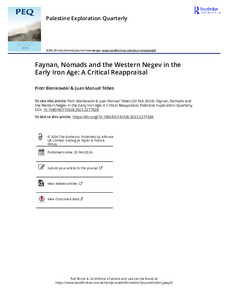Por favor, use este identificador para citar o enlazar este ítem:
https://repositorio.uca.edu.ar/handle/123456789/18313| Título: | Faynan, nomads and the western Negev in the Early Iron Age: a critical reappraisal | Autor: | Bienkowski, Piotr Tebes, Juan Manuel |
Palabras clave: | EDAD DE HIERRO; NOMADISMO; METALURGIA; ORIENTE MEDIO; ARQUEOLOGIA; COBRE | Fecha de publicación: | 2024 | Editorial: | Taylor & Francis | Cita: | Bienkowski, P., Tebes, J. M. Faynan, nomads and the western Negev in the Early Iron Age: a critical reappraisal [en línea]. Palestine Exploration Quarterly. 2024, febrero. doi: 10.1080/00310328.2023.2277628. Disponible en: https://repositorio.uca.edu.ar/handle/123456789/18313 | Resumen: | Abstract: The final report on the Edom Lowlands Regional Archaeology Project concludes that local nomadic tribes created a complex polity at early Iron Age Faynan, in southern Jordan, that was responsible for a radical shift in copper production to an industrial scale. Erez Ben-Yosef has subsequently used these conclusions as the key example in a theoretical argument about the social complexity – and, usually, archaeological invisibility – of nomadic societies. A review of the archaeological evidence from Faynan indicates that the sudden change at the beginning of the 10th century BCE should not be attributed to local nomads. Evidence from the Wadi Fidan 40 cemetery – both material culture and chemical analysis of teeth – shows that its nomadic inhabitants did not actively participate in the copper industry. There is no evidence of a process of transition from nomadism to sedentarism at Faynan, and its architecture does not reflect any influence or antecedents in the archaeology of nomads. The evidence shows close material culture connections with the western Negev and the major site of Tel Masos. The scenario that best fits the evidence is that Masos took direct control of copper production at Faynan and developed it as an industrial site to exponentially increase the copper trade – Masos had the resources, technical skills, an architectural tradition, and connections to trade networks that the local nomads lacked, and which transformed Faynan. Hundreds of sites in the Negev Highlands were settled by pastoralists who found employment both in production and transport in the burgeoning copper industry. The industrial transformation of Faynan, along with the settlement of Tel Masos and the Negev Highlands sites, was short-lived, and lasted little more than a hundred years. | URI: | https://repositorio.uca.edu.ar/handle/123456789/18313 | ISSN: | 0031-0328 (impreso) 1743-1301 (online) |
Disciplina: | CIENCIAS SOCIALES | DOI: | 10.1080/00310328.2023.2277628 | Derechos: | Acceso abierto | Fuente: | Palestine Exploration Quarterly. 2024, febrero |
| Aparece en las colecciones: | Artículos |
Ficheros en este ítem:
| Fichero | Descripción | Tamaño | Formato | |
|---|---|---|---|---|
| faynan-nomads-western-negev.pdf | 3,84 MB | Adobe PDF |  Visualizar/Abrir |
Este ítem está sujeto a una Licencia Creative Commons

